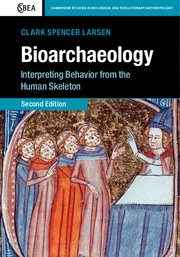Book contents
- Frontmatter
- Dedication
- Contents
- Preface to the Second Edition
- Preface to the First Edition
- 1 Introduction
- 2 Stress and deprivation during growth and development and adulthood
- 3 Exposure to infectious pathogens
- 4 Injury and violence
- 5 Activity patterns: 1. Articular degenerative conditions and musculoskeletal modifications
- 6 Activity patterns: 2. Structural adaptation
- 7 Masticatory and nonmasticatory functions: craniofacial adaptation to mechanical loading
- 8 Isotopic and elemental signatures of diet, nutrition, and life history
- 9 Biological distance and historical dimensions of skeletal variation
- 10 Bioarchaeological paleodemography: interpreting age-at-death structures
- 11 Bioarchaeology: skeletons in context
- References
- Index
- Plate section
9 - Biological distance and historical dimensions of skeletal variation
Published online by Cambridge University Press: 05 April 2015
- Frontmatter
- Dedication
- Contents
- Preface to the Second Edition
- Preface to the First Edition
- 1 Introduction
- 2 Stress and deprivation during growth and development and adulthood
- 3 Exposure to infectious pathogens
- 4 Injury and violence
- 5 Activity patterns: 1. Articular degenerative conditions and musculoskeletal modifications
- 6 Activity patterns: 2. Structural adaptation
- 7 Masticatory and nonmasticatory functions: craniofacial adaptation to mechanical loading
- 8 Isotopic and elemental signatures of diet, nutrition, and life history
- 9 Biological distance and historical dimensions of skeletal variation
- 10 Bioarchaeological paleodemography: interpreting age-at-death structures
- 11 Bioarchaeology: skeletons in context
- References
- Index
- Plate section
Summary
Introduction
Human remains are a central data source for documenting temporal and spatial patterning of biological relatedness. Determination of biological relatedness has traditionally been achieved via analysis of phenotypic skeletal and dental traits and their intra- and inter-population variation. Biological distance or biodistance analysis is based on the premise that the variation in morphological traits of the skeleton reflects underlying genotypic variation. Although biodistance analysis pertains largely to characterizing phenotypic variation, genotypic variation is becoming increasingly important via the study of ancient DNA (aDNA).
Regardless of the type of biodistance data, the degree of relatedness presupposes that a greater frequency of shared attributes indicates closer genetic affinity than a lower frequency of shared attributes. In this regard, the orientation of the research is linked to the questions being asked about intra- and inter-population interactions, ranging from continental-scale, containing many sites, to regional-scale containing multiple sites, to single site analyses focusing on individual variation within a population (Figure 9.1).
Biodistance analysis is motivated by three key interests (after Buikstra et al., 1990). First, results are important for investigation of issues relating to evolutionary history, such as genetic drift and selection, gene flow, and the influence of geography and other isolating mechanisms on biological relatedness (Conner, 1990; Droessler, 1981; Heathcote, 1994; Ossenberg, 1986; Rothhammer & Silva, 1990; Sciulli, 1990; Scott & Turner, 1997; Stojanowski & Schillaci, 2006). By understanding the degree of relatedness, it becomes possible to characterize temporal relationships in the identification of local in situ development, or migration, or some combination thereof (Konigsberg, 2006).
- Type
- Chapter
- Information
- BioarchaeologyInterpreting Behavior from the Human Skeleton, pp. 357 - 401Publisher: Cambridge University PressPrint publication year: 2015
- 2
- Cited by

